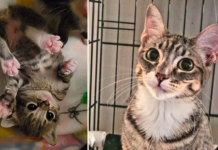Last Updated on September 6, 2023 by Fumipets
Understanding Shepadoodle Health: Care and Concerns
Shepadoodles, a crossbreed between German Shepherds and Poodles, are known for their intelligence and versatility. Like all dogs, they have specific health considerations that owners should be aware of.
Here’s a summary of Shepadoodle health, along with answers to common questions about their well-being:
Key Points about Shepadoodle Health:
-
Hybrid Vigor: Shepadoodles often benefit from hybrid vigor, which can lead to improved overall health compared to purebred dogs. However, they can still inherit genetic traits from their parent breeds.
-
Common Health Concerns: Shepadoodles can be prone to certain health issues, including hip dysplasia, bloat, and allergies. Regular veterinary check-ups and preventive care are essential.
-
Exercise and Mental Stimulation: These dogs are active and intelligent, requiring daily exercise and mental stimulation to stay healthy and happy. Failure to provide this can lead to behavioral issues.
-
Grooming Needs: The Poodle influence in Shepadoodles means they may have a curly or wavy coat that requires regular grooming to prevent matting and maintain their skin health.
-
Nutrition: Providing a balanced and high-quality diet is crucial to support their overall health. Consult your veterinarian for dietary recommendations based on your dog’s age and activity level.
Shepadoodle Dog Breed
Shepadoodles don’t come in a standard shape or size. The German shepherd and standard poodle hybrid, like other mixed breed canines, get characteristics from both parent types, so the dogs can vary in height, weight, look, and disposition. German shepherds are renowned for their thick, dense, black and brown coats, but these canines can also have curlier, low-shedding coats, which are characteristic of their poodle parent.
Shepadoodles maintain their resemblance to their ancestors, the energetic, clever German shepherd and poodle types. Because shepadoodles are descended from two working canine types, he requires a lot of activity, constant instruction, and will be happy when given a task to complete.
Appearance
Shepadoodles are big canines, just like German shepherds and regular poodles. Shepadoodles are a hybrid breed, so their size ranges from 60 to 90 pounds and their height ranges from 22 to 28 inches at maturity. Depending on which parent they resemble more than the other, these puppies can have completely distinct looks.
Many shepadoodles have thick, dense, black and brown bodies that resemble those of German shepherds. But there’s no doubt that their fur display poodle impact.
Even though black shepadoodles are popular, you can also find ones with white, cream, and tawny bodies.
Temperament
Despite their significant differences in look, German shepherds and poodles have some characteristics in common. Both, according to Hammond, were bred to be working canines and are coveted for their wits, physical prowess, trainability, and need for mental stimulus. Shepadoodles, a cross between a German shepherd and a poodle, exhibit all of these traits.
For seasoned canine caretakers, a well-exercised (and well-trained!) shepadoodle makes a wonderful friend. In order to prevent his keen intellect from becoming tired, he requires a master who can keep him occupied and interested.
Both German shepherds and poodles form close relationships with their families and enjoy company, play, and love. Shepadoodles are no different; their families should be ready to satisfy their social requirements since these are not canines that enjoy spending a lot of time alone.

Living Needs
According to Hammond, the shepadoodle does best in a setting with plenty of room, socialization, exercise, and training. They must be able to move around freely, play, and exercise a lot.
Shepadoodle puppies must have access to a fenced-in yard to run and play, but Hammond advises against rearing one in an apartment for other reasons as well. She claims that German dogs and poodles are both great barkers who will raise the alert in the event of transports or neighborly commotion. Therefore, if you don’t want your neighbors to give you passive-aggressive looks in the corridor, consider carefully before bringing a shepadoodle home. (or commit to training them not to bark at passersby).
You shouldn’t anticipate your shepadoodle to amuse himself even with a yard. Shepadoodles are energetic canines who enjoy swimming, jogging, and climbing. Expect to spend a few hours a day assisting your shepadoodle expend his energy because this is not a canine who will be content with a short stroll around the block.
Shepardoodles can play well with older kids and get along well with other large dogs, but they might view tiny canines and cats as prey to pursue. Additionally, large shepadoodles might be too active for a household with young children due to their size.
Care
A shepadoodle cross requires frequent mental and physical activity to remain content. The type thrives in flyball, agility, and obedience. Take the canines outside on a lead and let them explore their surroundings through scent training, which Hammond also recommends for these dogs in a structured or casual situation.
Training is important. Shepadoodles are not only extremely clever and anxious to learn new things, but they will also become restless and engage in undesirable behaviors like gnawing or howling if not given enough mental stimulus.
This canine is extremely intelligent, so it needs firm guidance and instruction. Shepadoodles and their young owners develop a vital connection through training. Use positive training techniques and encourage your shepadoodle’s excellent conduct as you would with any canine.
Grooming is a further component of shepadoodle upkeep. He’ll need to be groomed several times each week, whether he gets the curled poodle hair or the smooth, tough coat of the German shepherd. You’ll also need to plan routine visits with an expert groomer if your shepadoodle has a frizzy hair.
As part of providing for your shepadoodle, bear in mind that regular teeth cleanings, flea, tick, and heartworm preventives must be given on a monthly basis. Additionally, examine and clear his ears, particularly if he spends a lot of time swimming.

Health
Shepadoodles have a typical lifetime of 10 to 14 years and are generally robust canines. However, they are prone to some parentally transmitted medical conditions.
Progressive retinal atrophy, a collection of eye conditions that result in the degeneration of retinal cells and blindness, is more common in poodles. Although there is no discomfort associated with the illness, it can be detected in pups and senior canines. Unfortunately, there is no cure. To prevent cataracts and maintain eyesight, your veterinarian may advise taking vitamin pills.
Degenerative myelopathy, a different ocular condition, affects German dogs frequently. Lack of balance and shuffling feet are the first signs of this degenerative illness that affects the spinal nerve and results in weakening and immobility of the rear limbs. Degenerative myelopathy cannot be cured or treated.
German dogs are frequently identified with hip deformity as well. Because the joint and cavity do not fit together, it is a disease that causes the hip joints to pulverize. Surgery, manual rehabilitation, and anti-inflammatory drugs are typical therapies.
The most important health issue for shepadoodles to be mindful of is stomach dilatation volvulus, also known as bloat. Gas strains the stomach, causing it to contort and block off blood flow to the stomach, which is a life-threatening situation. German shepherds and poodles, as well as other types with wide chests and slender waists, are both susceptible to bloating. Breeds that are prone to bloating may benefit from gastropexy, a preventative treatment that includes sewing the stomach to the side of the body.
History
The desire for the customized breed increased after the first “doodle” canine (a Labradoodle) was developed in the 1980s. This sparked interest in poodle-German shepherd crosses, among other types.
Shepadoodle mixes are not recognized as separate breeds by the American Kennel Club, so neither their disposition nor outward look are subject to any established standards. Furthermore, little is known about the breed’s history because there is no official breed registry.
However, the progenitor varieties of the shepadoodle both have lengthy histories. The Poodle is the official canine of France and was developed in Germany as a sporting companion. Another German type, German shepherds have a lengthy history of serving as service canines for armies and security forces all over the globe.
Common Questions about Shepadoodle Health:
Are Shepadoodles hypoallergenic?
While Poodles are considered hypoallergenic, Shepadoodles may inherit this trait to some extent. However, individual sensitivity to allergens can vary.
How can I prevent hip dysplasia in my Shepadoodle?
Regular exercise, maintaining a healthy weight, and responsible breeding practices can help reduce the risk of hip dysplasia.
Do Shepadoodles require specific training?
Shepadoodles are intelligent and benefit from consistent training and socialization to ensure they become well-behaved companions.
Can Shepadoodles live in apartments?
Shepadoodles are active dogs and thrive in homes with ample space for exercise. However, they can adapt to apartment living with daily exercise and mental stimulation.
What is the average lifespan of a Shepadoodle?
The lifespan of a Shepadoodle typically ranges from 10 to 14 years, depending on their overall health and genetic factors.
https://www.youtube.com/watch?v=1XOjD_JmPH4


















